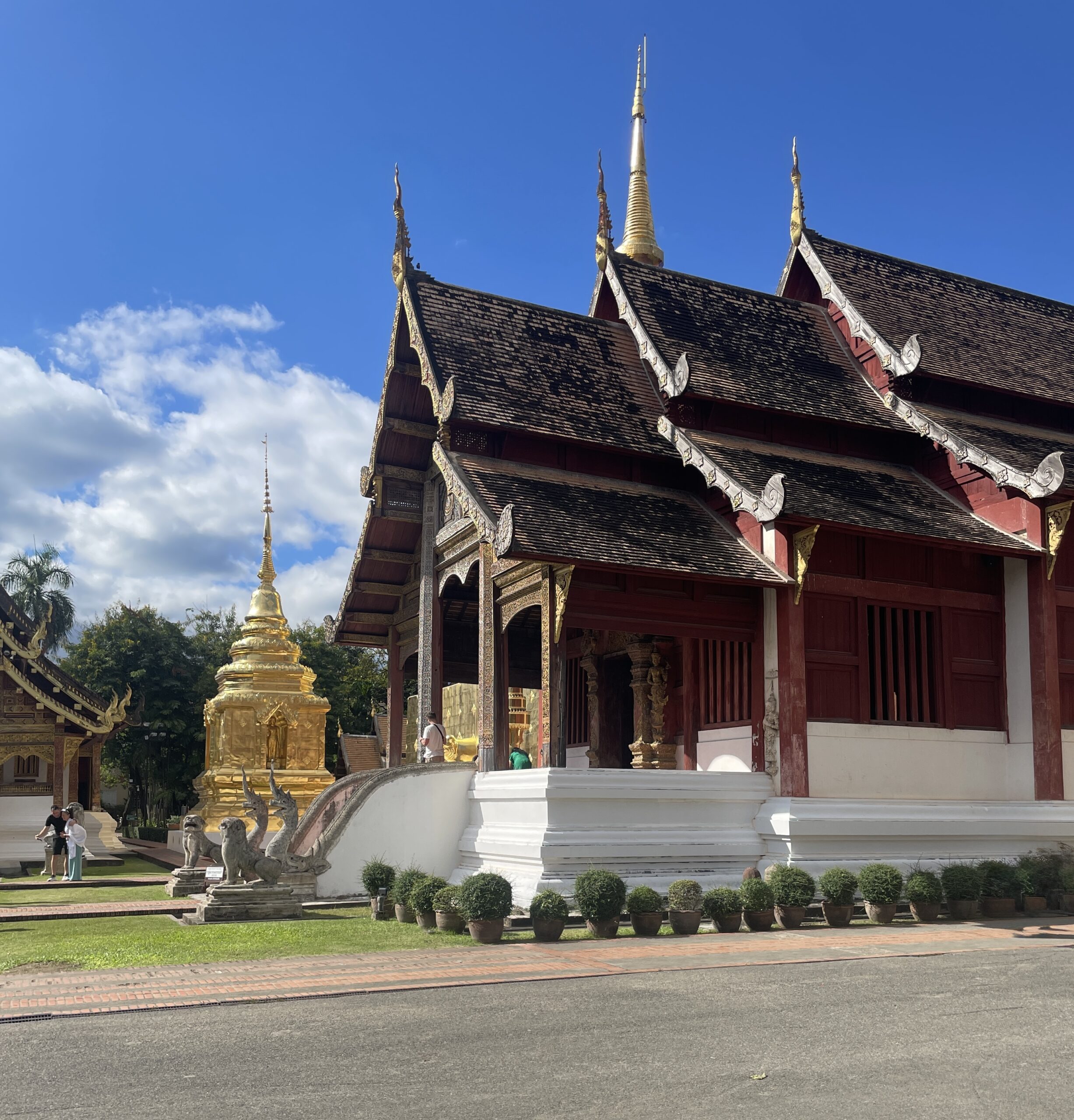Where to Stay in Chiang Mai: 7 Best Areas & Hotels
Chiang Mai is one of those rare destinations that feels instantly comfortable and endlessly fascinating at the same time.
Nestled in northern Thailand and surrounded by misty mountains, it’s a city of contrasts: ancient temples next to coworking cafés, bustling street markets across from quiet moats, and days that can be as laid-back or as adventure-filled as you want them to be.
Choosing where to stay in Chiang Mai isn’t just about picking a place to sleep; it’s about deciding the kind of trip you want to have.
If you’ve only got a few days, here’s how I’d spend 4 perfect days in Chiang Mai to help you plan around the right neighborhood.
I’ve stayed all over Chiang Mai, from the heart of the Old City to quieter neighborhoods tucked beside the Ping River.
And every area offers something different, with easy access to many of the top things to do in Chiang Mai that make the city so special.
Whether you’re visiting for a few days or settling in for a longer stay, this guide will help you figure out which neighborhood fits your vibe.
Old City
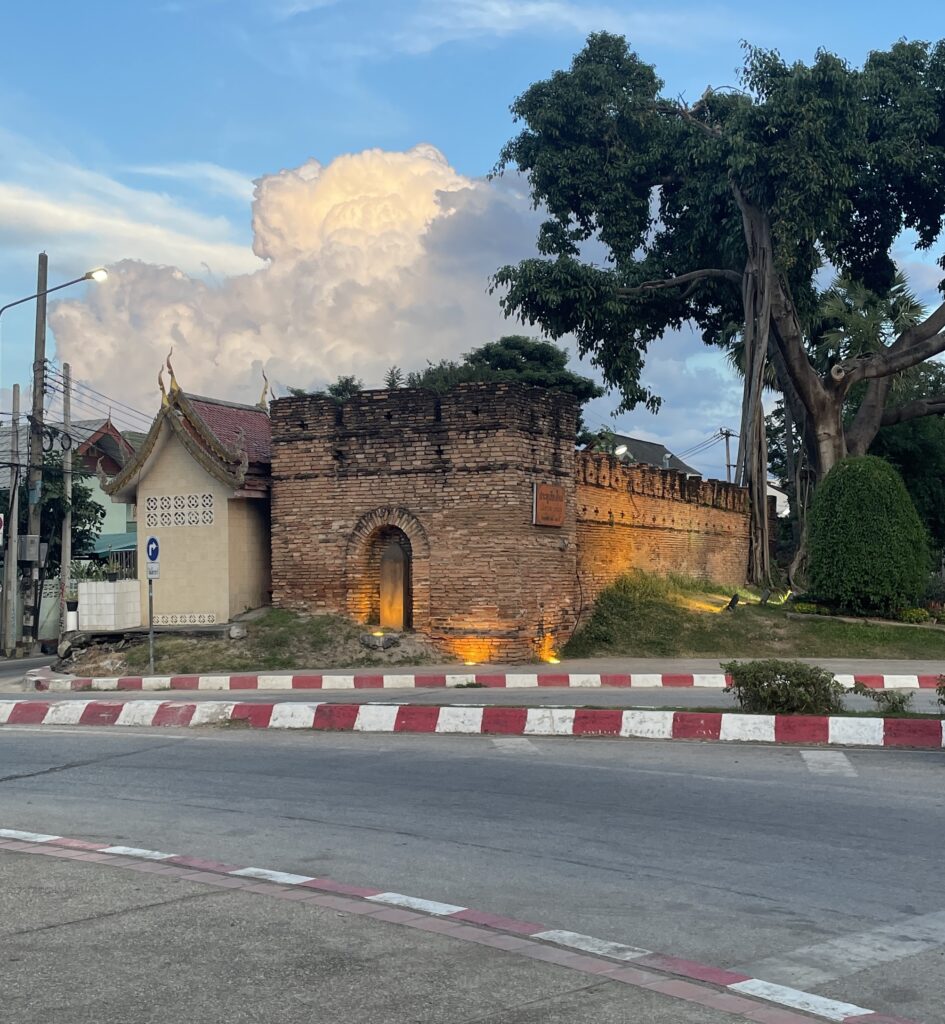
- Good for: First-timers, culture lovers, temple explorers
- Vibe: Historic, walkable, tourist-friendly
- Pros & Cons: Central and charming with loads to see, but can get busy and touristy
If it’s your first time in Chiang Mai, staying inside the Old City walls is the best way to get your bearings.
This is the beating heart of the city, a compact square surrounded by ancient brick walls and a moat, filled with over 30 temples, traditional guesthouses, trendy cafés, and bustling markets.
You can spend hours here wandering alleyways, sipping iced Thai tea, and stumbling upon serene courtyards that feel worlds away from the motorbike hum outside.
The Sunday Night Market starts right here and winds through the Old City streets, transforming the whole area into a food and craft lover’s paradise.
The downside? Because it’s so convenient and atmospheric, it’s also the most touristy part of town. Prices are a bit higher, and during high season, it can feel crowded. But if you want a taste of classic Chiang Mai with everything within walking distance, the Old City is a winner.
Top Hotels in Old City
Tamarind Village Chiang Mai – Luxury
BED Phrasingh Hotel – Mid-Range
Green Tiger House – Budget
Nimmanhaemin (Nimman)
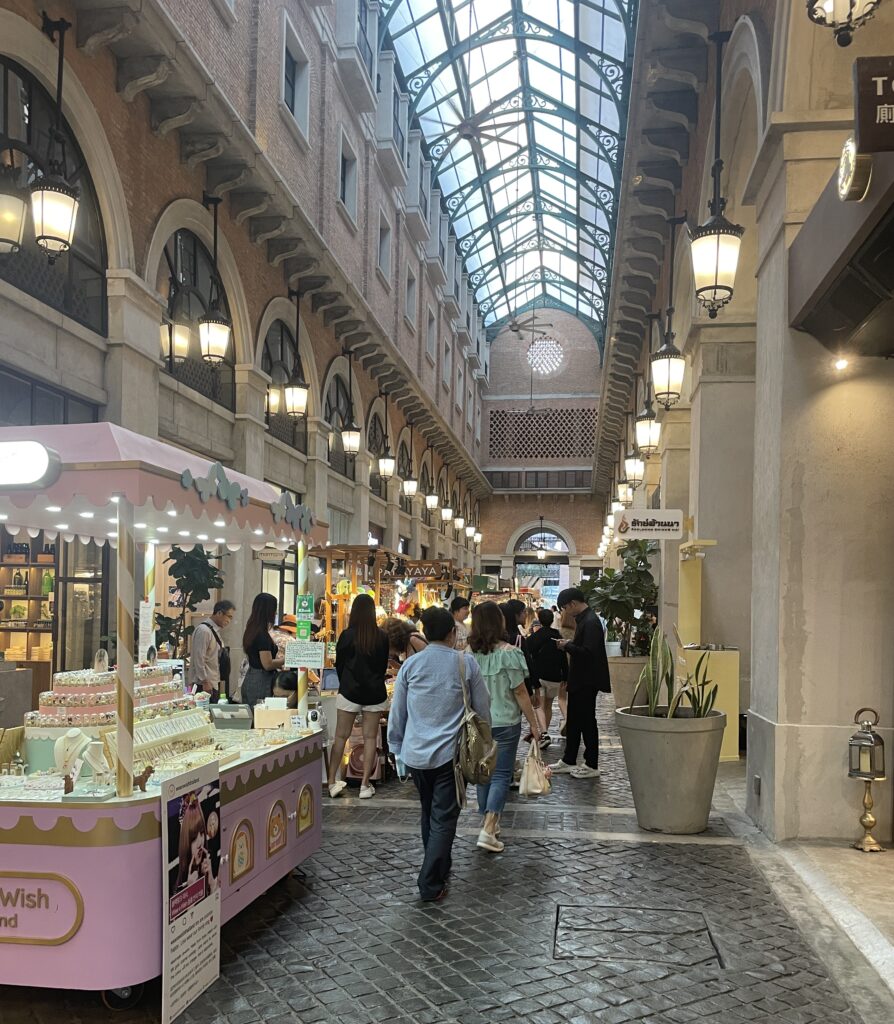
- Good for: Digital nomads, trendy travelers, long stays
- Vibe: Modern, youthful, creative
- Pros & Cons: Hip and convenient, but lacks historic charm
Nimmanhaemin, or just “Nimman,” is Chiang Mai’s most stylish and modern neighborhood. Think coworking spaces, Instagrammable cafés, boutique malls, and smoothie bowls galore.
It’s a favorite for digital nomads and long-term visitors thanks to the fast Wi-Fi, walkable streets, and proximity to Chiang Mai University. The neighborhood buzzes with young energy and creativity, offering everything from art galleries to night markets and rooftop bars.
You won’t find temples or historic landmarks here, but you will find great brunches, quiet apartments, and leafy side streets that feel like a city within a city.
Maya Mall anchors the area and offers a good selection of shops, restaurants, and even a cinema, perfect for rainy days or a low-key night out.
Nimman is also well-connected to both the Old City and the airport, and Doi Suthep mountain is a short drive away if you need a nature break.
The neighborhood has a cosmopolitan feel, making it ideal for travelers who want comfort, convenience, and a taste of Chiang Mai’s more modern side.
If you’re in Chiang Mai to work, relax, and live more than sightsee, Nimman is the spot.
Top Hotels in Nimmanhaemin
U Nimman Chiang Mai – Luxury
Sanae Hotel Chiang Mai – Mid-Range
Nimman Mai Design Hotel – Budget
Riverside / Wat Ket
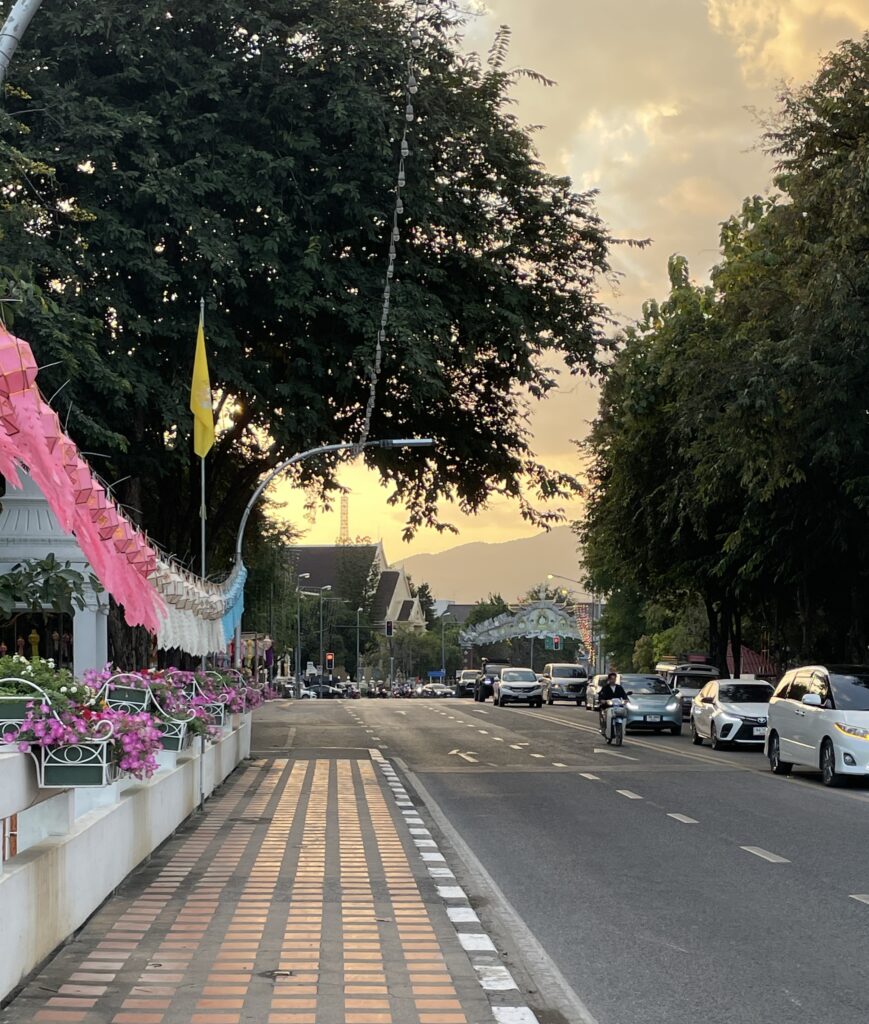
- Good for: Couples, relaxed luxury, scenic views
- Vibe: Peaceful, upscale, riverside
- Pros & Cons: Gorgeous riverside settings, but farther from city center
Located along the Ping River and just across from the Old City, the Riverside (including Wat Ket) area is ideal for travelers who want something quieter and more refined.
It’s home to some of Chiang Mai’s best boutique hotels and romantic resorts, many with stunning river views and lush garden settings.
There’s also a growing collection of wine bars, stylish restaurants, coffee shops, and craft shops, especially near the Iron Bridge and Charoenrat Road.
You’ll need to Grab or tuk-tuk into the Old City or Nimman, but the trade-off is tranquility and space.
If you’re celebrating something special or want a more relaxed base, this area delivers.
Top Hotels in Riverside
137 Pillars House – Luxury
Rimping Village – Mid-Range
Rustic River Boutique – Budget
Santitham
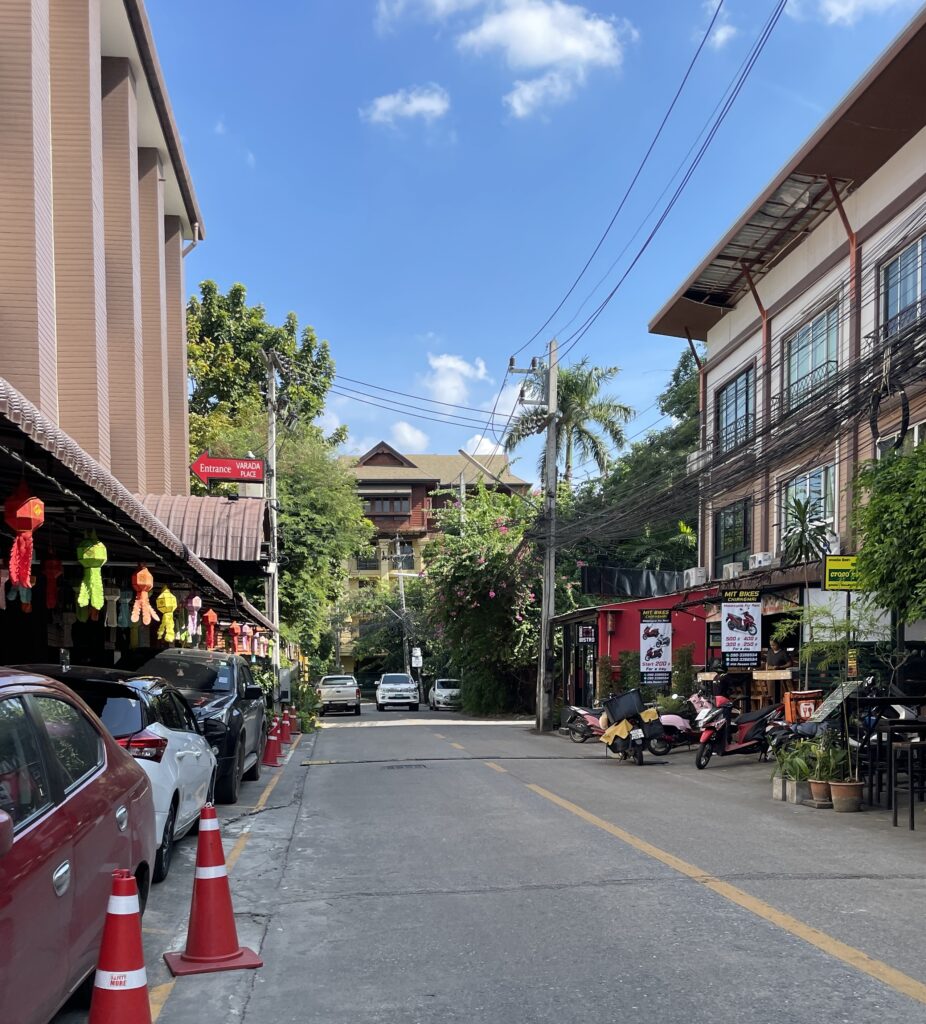
- Good for: Local vibes, budget travelers, longer stays
- Vibe: Residential, low-key, local
- Pros & Cons: Cheap and authentic, but not walkable to major attractions
Just north of Nimman and west of the Old City, Santitham flies under the radar for most tourists.
But if you want a more local, budget-friendly experience, this neighborhood delivers.
It’s a mostly residential area with night markets, simple guesthouses, and a growing expat presence. Food is cheaper, traffic is lighter, and the pace is slower.
While it lacks major sights or polished restaurants, that’s part of the appeal, this is everyday Chiang Mai. You’ll find low-rise apartments, street-side noodle stalls, and mom-and-pop cafés serving up strong coffee for half the price of Nimman.
It’s also one of the few areas where you can still feel the rhythms of the local community without feeling totally cut off. Songthaews run through regularly, and it’s a quick Grab ride to anywhere central.
This isn’t where you’ll find luxury stays or curated charm, but if you’re in Chiang Mai for a month or more and want a chill, affordable base, Santitham is solid.
Top Hotels in Santitham
POR Santitham – Mid-Range
Baan Heart Thai – Budget
Night Bazaar Area (Chang Khlan)
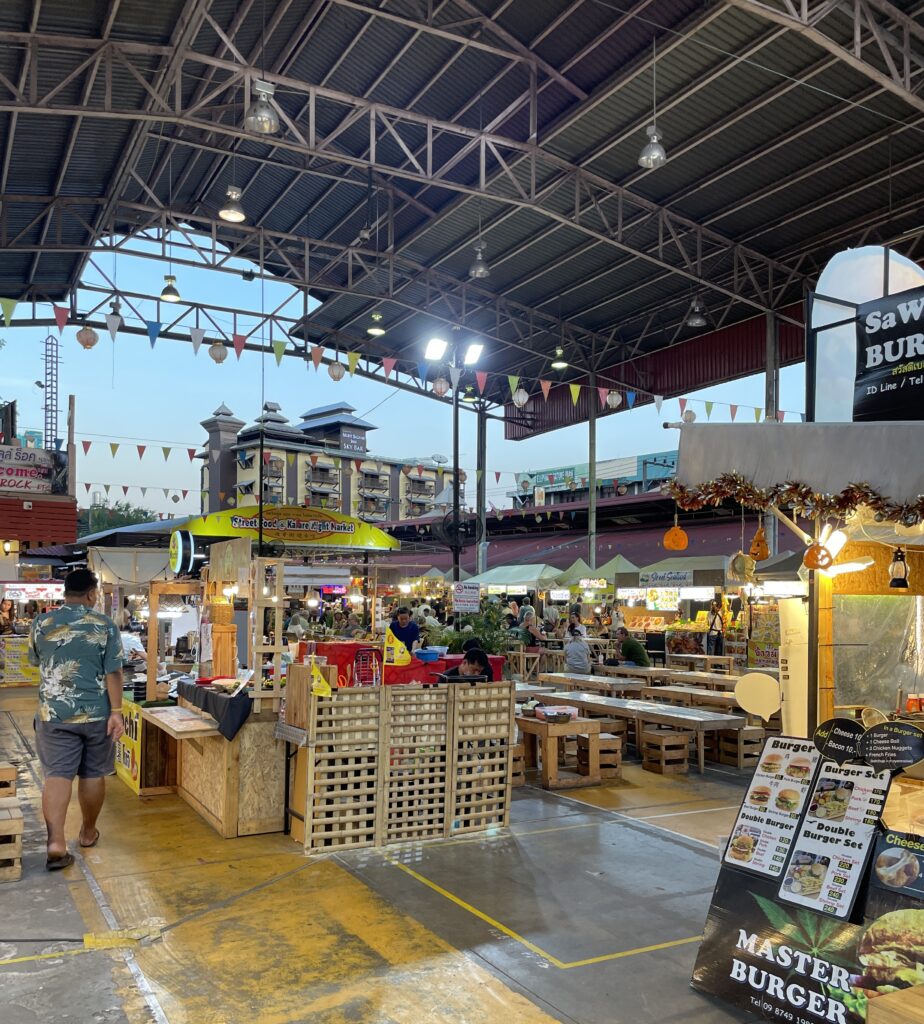
- Good for: Shoppers, nightlife, short visits
- Vibe: Bustling, commercial, central
- Pros & Cons: Convenient and active, but touristy and sometimes dated
If you’re in Chiang Mai for just a few days and want fast access to markets, bars, and easy transport, the Night Bazaar area (around Chang Khlan Road) works well.
This is where you’ll find the famous Night Bazaar, plus a mix of hotels, convenience stores, currency exchange booths, and late-night food.
It feels a bit more like a tourist hub than other neighborhoods, but it’s efficient.
You’ll be within walking distance of the Old City, the Ping River, and several other busy commercial zones, making it easy to explore without needing constant transport.
There’s also a range of mid-range hotels and large international chains, which makes it popular with group tours and families who want predictability.
It’s not the most charming or peaceful district, but it’s central and packed with action, suitable for first-time travelers who prioritize location and nightlife.
Top Hotels in Night Bazaar Area
Shangri-La Chiang Mai – Luxury
The Empress Hotel – Mid-Range
Chang Moi
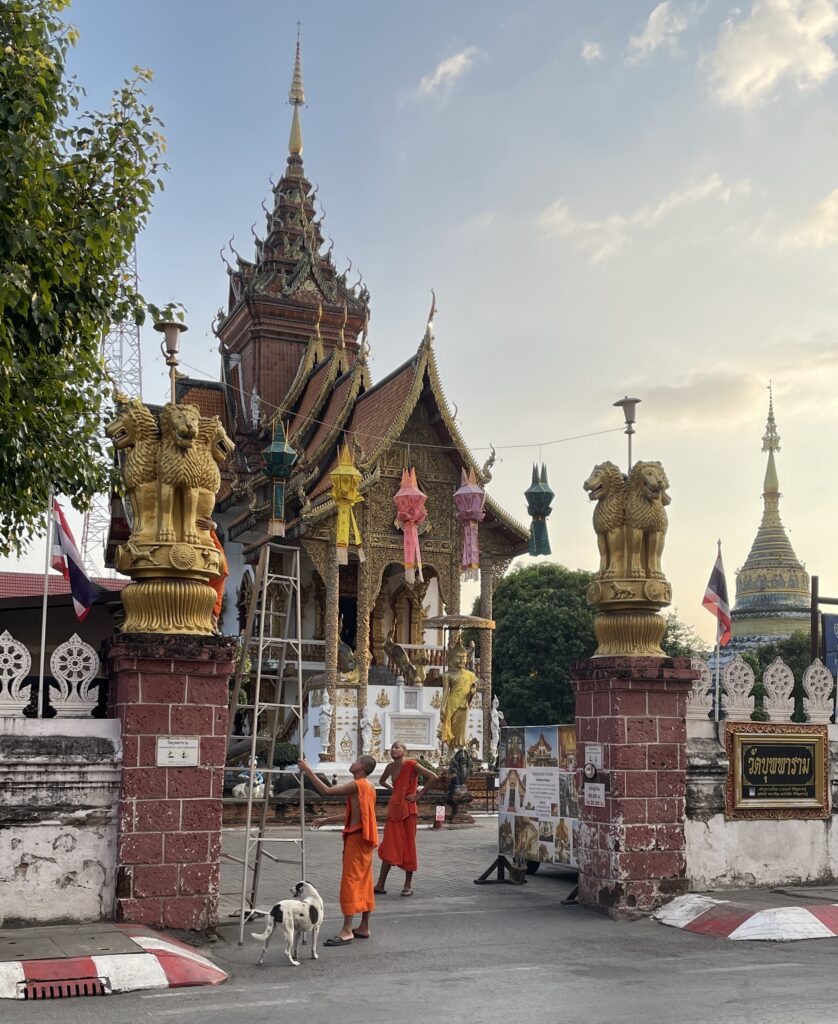
- Good for: Foodies, creatives, digital nomads
- Vibe: Trendy, walkable, artsy
- Pros & Cons: Easy access to the Old City and Night Bazaar, but can get busy and touristy in parts
Chang Moi sits just east of the Old City and has quietly become one of Chiang Mai’s coolest corners.
Think vintage shops, craft coffee bars, tucked-away cocktail lounges, and alleyways covered in street art. It’s a popular area for digital nomads and travelers who want to be close to the action but not smack in the middle of it.
You’re also within walking distance of the Night Bazaar and Tha Phae Gate, which makes it super convenient if you’re staying for just a few days and want a blend of local flavor and tourist access.
The area’s creative energy extends into its small galleries and boutique guesthouses, giving it a stylish but unpretentious feel.
It’s not as calm or leafy as Nimmanhaemin or Wat Ket. Still, if you like a little grit with your cold brew, this area has plenty of charm, a great mix of convenience and character, especially for those who value a walkable base with personality.
Top Hotels in Chang Moi
The Inside House – Luxury
My Chiang Mai Boutique Lodge – Mid-Range
Hang Dong
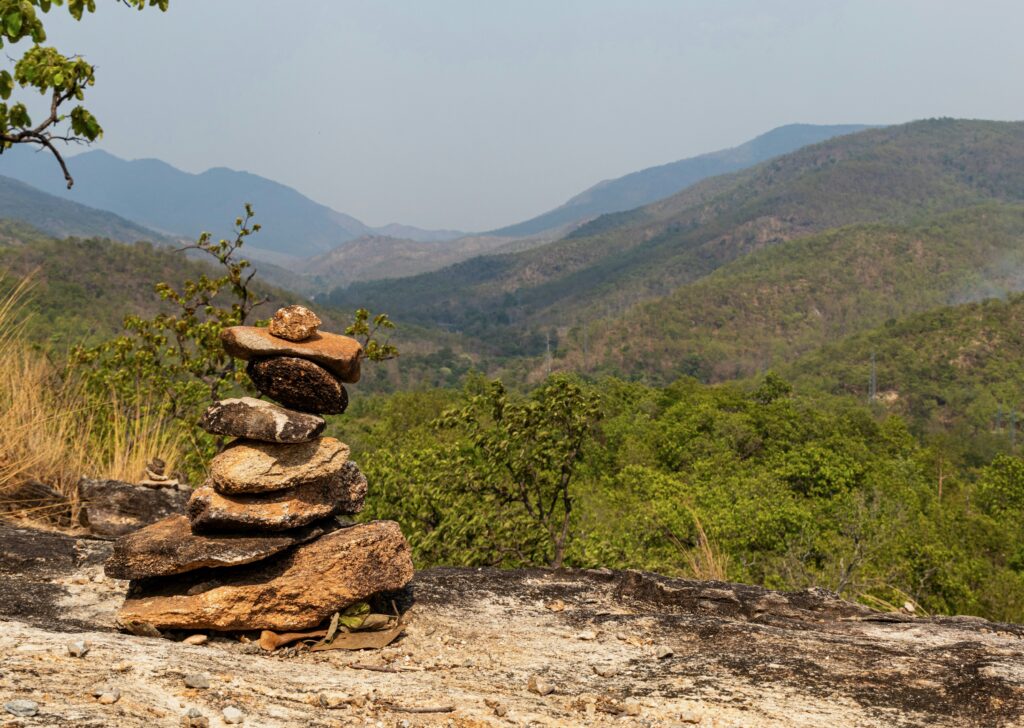
- Good for: Retreats, peace, nature lovers
- Vibe: Rural, green, quiet
- Pros & Cons: Scenic and serene, but far from central Chiang Mai areas
Hang Dong is a district southwest of Chiang Mai that offers countryside vibes, luxury villas, and wellness retreats. It’s ideal for travelers looking to unplug or spend time in nature.
You’ll find yoga centers, jungle resorts, and views of rice paddies and rolling hills. It’s not walkable to anything and requires transportation to get into town, but that’s part of the appeal.
This area feels more like rural northern Thailand than a Chiang Mai suburb, with quiet roads, farm-to-table cafés, and boutique properties hidden in the hills.
It’s also close to outdoor attractions like the Grand Canyon Water Park and various waterfalls, making it a great pick for nature lovers and weekend adventurers.
Hang Dong is a good choice if you’re staying longer and want peace and quiet. It’s especially popular with couples and remote workers who don’t need to be near the action.
Top Hotels in Hang Dong
Veranda High Resort Chiang Mai – Luxury
North Hill City Resort – Mid-Range
Getting from Chiang Mai Airport to the City
Chiang Mai International Airport is one of the most conveniently located airports in Thailand. Unlike in Bangkok or even Phuket, where airport transfers can take ages, here you’re just 10–15 minutes away from the city center.
Whether you’re heading to the Old City, Nimman, or Riverside, getting from the airport to your hotel is refreshingly hassle-free.
- Grab: The easiest and most affordable option. Just book through the app and follow the signs to the Grab pickup zone outside the arrivals terminal. It’s usually just a few minutes’ wait, and prices are transparent.
- inDrive: Another rideshare option that’s gaining popularity. Unlike Grab, inDrive lets you name your price, and drivers can accept or counter the offer. It works best if you already have the app set up before arriving.
- Airport Taxi: In Chiang Mai, airport taxis are surprisingly reliable, more so than in many other Thai cities. You’ll see official service counters as soon as you exit baggage claim. Tell them your destination, pay a flat rate (usually around 150–200 THB), and you’ll be on your way in minutes. Just note that taxis only accept cash, so keep some small bills handy.
- Hotel Transfers: Some hotels offer free or paid airport pickups, which can be convenient if you’re arriving late or want extra peace of mind. Always arrange this in advance.
Avoid random drivers offering “cheap rides” inside the terminal. While Chiang Mai is generally safer and more laid-back than other Thai cities, scams in Chiang Mai can happen, especially around transport.
These unofficial rides often come with surprise fees, unnecessary detours, or pressure to stop at commission-based travel agencies.
Stick with trusted services, and you’ll be checked in at your hotel before the sun sets.
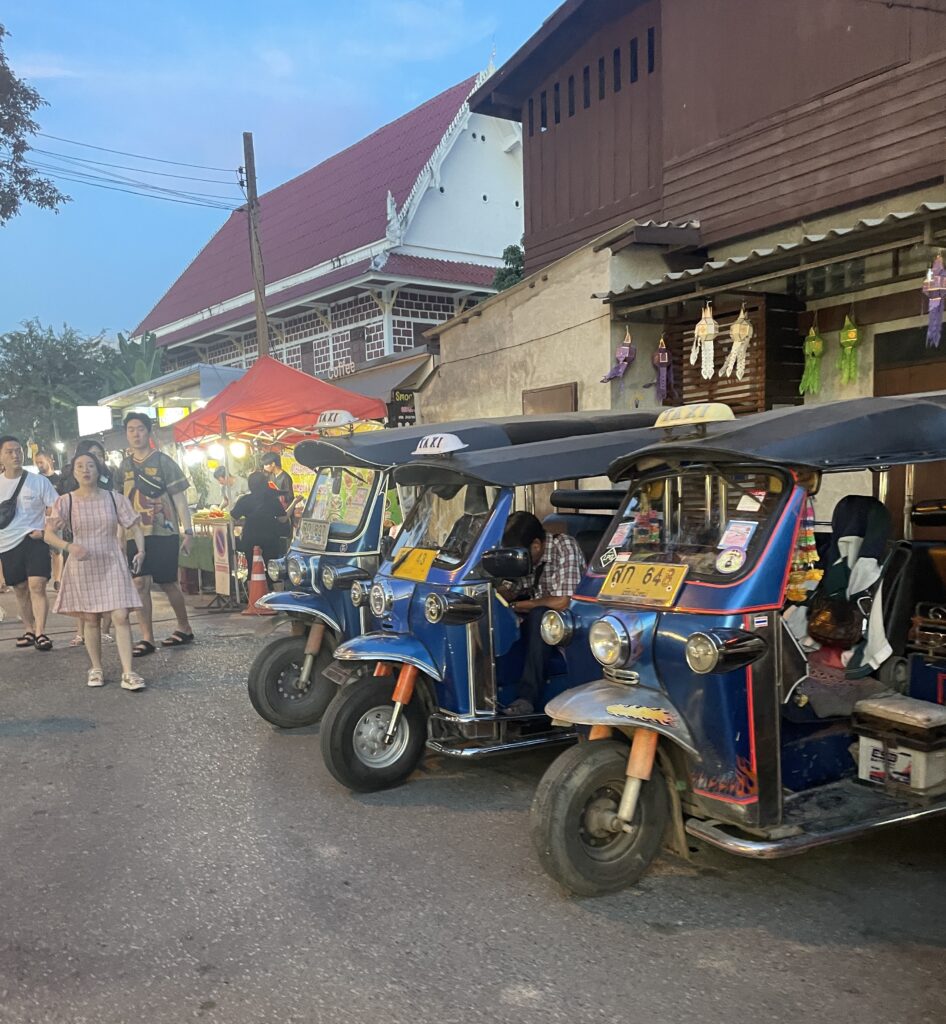
Tips for Booking Hotels in Chiang Mai
- Book Early in Peak Season: November to February is high season, especially during the Yi Peng Lantern Festival. Hotels book up very fast that weekend.
- Noise Sensitivity? Avoid the Old City near Tha Pae Gate if you want quiet. Opt for Riverside or Hang Dong.
- Digital Nomad? Look for monthly rental deals in Nimman or Santitham.
- Read Guest Reviews Carefully: Some budget places overpromise on amenities or cleanliness.
- Transportation: Most areas require short Grab rides. Don’t pick a place just for walkability; Chiang Mai is more spread out than it seems.
How to Get Around Chiang Mai
Chiang Mai isn’t massive, but it’s definitely not walkable in the way small towns are; you’ll need wheels or a game plan.
Thankfully, getting around the city is super easy, and honestly, part of the fun. Here’s how I get from temple to café to night market without losing my sanity:
- Grab: Think of it as Southeast Asia’s Uber. Reliable, affordable, and app-based, you’ll use it a lot here. Great for airport pickups, cross-city errands, or just avoiding the heat. Fares are low, and rides rarely take more than 10–15 minutes.
- inDrive: This one’s gaining popularity. You set your price, the driver accepts (or counters), and off you go. It can be cheaper than Grab if you’re good at bargaining, but it’s slightly more hit-or-miss in Chiang Mai than in Bangkok.
- Red Songthaews: These are shared red trucks you’ll see everywhere. Just flag one down, tell the driver your destination, and hop in if they’re heading that way. It’s local, super cheap (20–40 THB), and kind of iconic, but don’t expect Google Maps-level efficiency.
- TukTuks: They’re not the cheapest way to get around, but they are the most fun. Expect to pay more than Grab, and always negotiate the price before hopping in. It’s more about the experience than practicality.
- Scooter Rentals: If you’re comfortable riding, this is the best way to explore hidden cafés and outer neighborhoods. You’ll find rental shops everywhere (especially in Nimman and near the Old City). Expect to pay around 150–250 THB/day. Don’t forget your international license, and please wear a helmet.
- Walking: Inside the Old City, walking is preferable and faster at times; it’s flat, compact, and packed with temples, restaurants, and markets. But beyond that, sidewalks are hit-or-miss, and the heat can be brutal midday.
- Bikes: Some hotels offer free rentals, and you’ll see a few tourists pedaling around. It’s scenic near the river or smaller lanes, but traffic and loose dogs can make it feel like a sport. Proceed with caution.
Bottom line? Grab + walking + the occasional red truck is usually all you need for a short trip. If you’re staying longer or want full independence, get a scooter and thank me later.
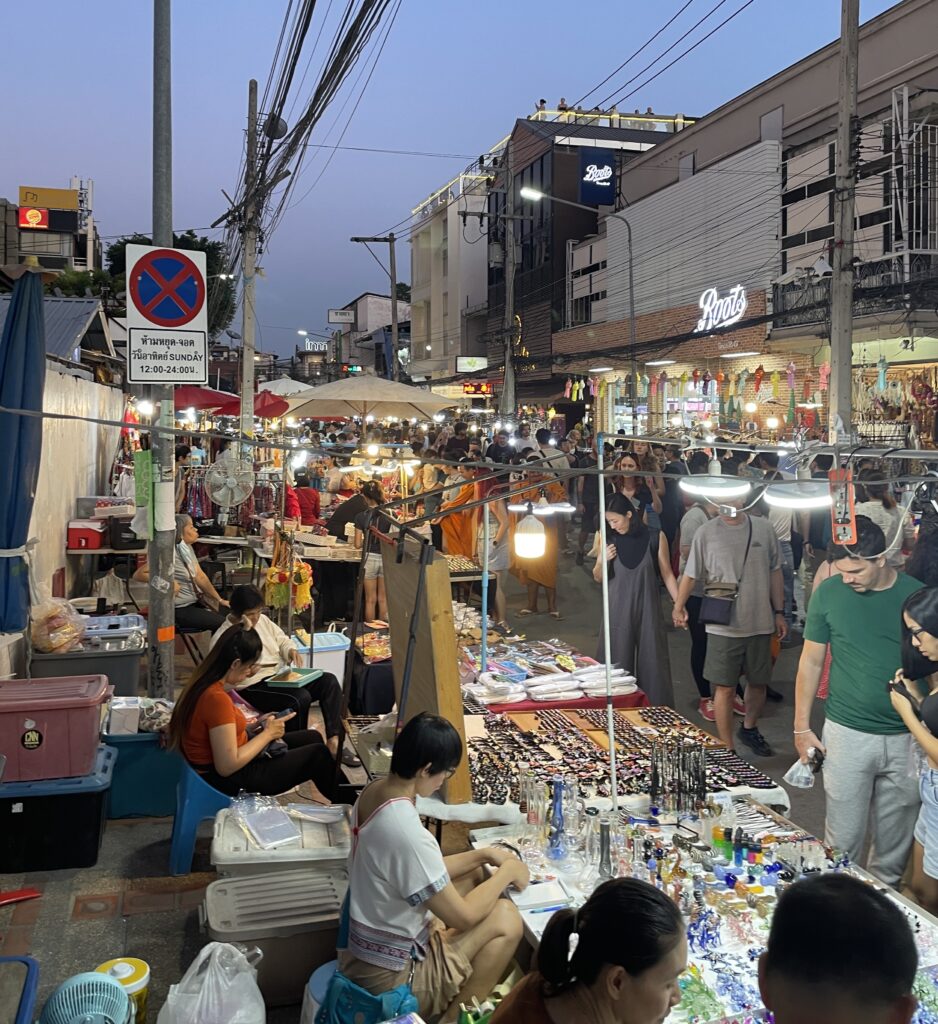
Final Thoughts: Best Areas in Chiang Mai to Stay
Chiang Mai has a rhythm all its own, and the neighborhood you choose will set the tone for your stay.
Want temples, tuk-tuks, and walking markets? The Old City is your place. Craving good coffee and a modern vibe? Nimman wins. Prefer riverside romance? Head to Wat Ket.
Each district brings a different flavor to your trip. The beauty of Chiang Mai is that you can try more than one, start central and finish on the outskirts, or vice versa.
Wherever you end up, give yourself time to soak in the slow pace and warm hospitality that makes this northern gem so magnetic.
And if you’re pairing your Chiang Mai trip with other destinations, don’t miss my Bangkok itinerary and Phuket travel guide, both packed with tips on what to do at night, where to go next, and how to plan it all smoothly.

What are the best neighborhoods to stay in Chiang Mai for first-time visitors?
The Old City is ideal for first-timers, offering walkability to major temples, the Sunday Walking Street market, and central cafés.
For a more modern, trendy vibe, Nimmanhaemin (Nimman) is popular among younger travelers and digital nomads. You’ll find everything from craft coffee to boutique coworking spaces.
Which area is best for food lovers in Chiang Mai?
If you’re chasing Thai street food, noodle soup, and local flavors, Santitham and Chang Moi are excellent picks.
Santitham is packed with hidden noodle stalls and local eateries, while Chang Moi has cool cafés and bars tucked among alleys. Both give you authentic meals without tourist crowds.
Where should digital nomads stay in Chiang Mai?
Nimmanhaemin consistently ranks as the go-to district for digital nomads thanks to its reliable Wi-Fi, abundance of cafés and coworking spaces, and young energy.
Santitham is another solid pick for longer stays, quieter, more local, and typically more affordable.
Is the Night Bazaar area a good place to stay?
Yes, Chang Khlan (Night Bazaar area) is super convenient for short stays, packed with hotels, nightlife, and the famous Night Bazaar market right out your door.
It’s walkable to the Old City and the Ping River, but can feel touristy and a bit dated in places.
Are there quiet areas in Chiang Mai for relaxation or longer stays?
Absolutely. Riverside (Wat Ket) offers serene river views and boutique hotels away from crowds.
If you want full peace and nature immersion, Hang Dong is your best bet, think countryside villas, retreats, and wellness resorts outside the city center.

